Electromotive force is the energy required to drive electrical charges through a conductor. A cell is the device that produces electrical potential difference at the ends of the conductor. The cell or the battery does the work of pumping charges to a high potential so that they can flow. The higher the potential difference (p.d), the stronger the current in the circuit while all other factors are held constant. Factors that affects currents made to flow by the electromotive force includes opposition to the flow of charges in the conductor. The opposition to the flow of charges is called resistance. It is a characteristic of the internal structure of the conductor.
Due to resistance, some energy supplied by the battery is lost in while moving charges through the battery itself. Total energy supplied by the battery is called it’s electromotive force(e.m.f). The electrical energy that actually moves charges around a circuit is called potential difference.
Potential difference is measured in volts by an instrument called voltmeter. Both potential difference (p.d) and electromotive force(e.m.f) are measured in volts. The figure below shows a voltmeter.
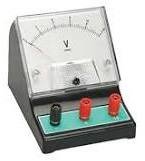
Another way of describing an electromotive force (e.m.f ) is that e.m.f is the voltage across the cell when it is not supplying any current. It is the potential difference in an open circuit. The figure below shows an open circuit.
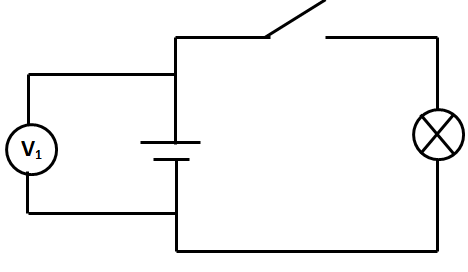
The voltmeter reading V1 is an electromotive force because it measures voltage in the cell when no current i flowing.
The figure below shows a closed circuit.
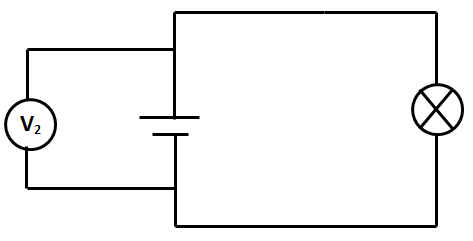
The difference between the electromotive force and the potential difference is referred to as the lost voltage.It is called lost voltage because it is the energy used to overcome internal resistances and not in driving charges. Opposition to the flow of charges within the cell is known as the internal resistance.
Water analogy to explain Electromotive force and potential difference
Flow of current can be compared to water flow. Water flows due to pressure difference between two points and stops flowing when the pressure is the same.
consider a tin containing water connected to another empty tin. The container full of water can be said to be at a higher potential.
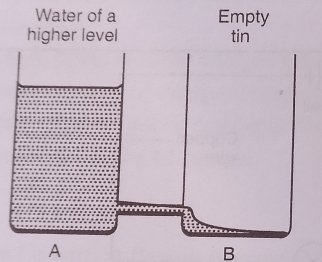
Water flows from tin A to tin B because the water in the two tins are at different levels. Water will flow until it is at the same level on the two containers as in diagram below. It then it will stop flowing.
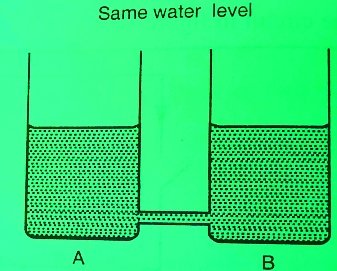
Similarly, current cannot flow between two points that are in the same Electrical potential.
We can make water circuit as shown in the figure below:
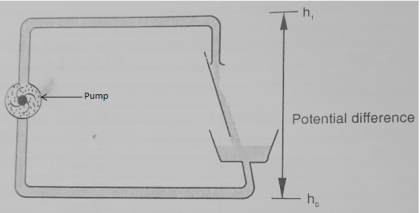
In the figure above, water flows round the tube in a complete circuit. Water at a height h1 has a potential difference due to it’s position above to to the ground.
Increasing the height results to increasing potential difference. The speed of water flow depends on the height at which the water had initially been raised.
A higher water level results into faster rate of flow. At height h0 that is on the ground, water has no potential energy. The pump is thus used to push water to height h1 so that it can have potential energy. When the pump is working, water will be moving around the tube in a completer circuit. This movement occurs from a point of higher potential energy h1 to a point of low potential energy h0 . The pump is the one creating this constant difference in potential so that there is continued circulation.
In an electric circuit, we replace water at the upper height h1 with positive charges. We replace the pipe with copper wires and the battery replaces the pump.
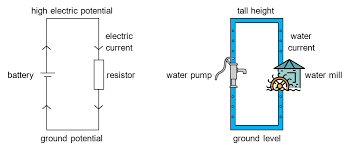
For the charges to move through the conductor, a battery is necessary. It produces an electrical potential difference at the ends of the conductor. The battery does the work of pumping charges to a high potential so that they can flow. The higher the potential difference (p.d) the stronger the current in the circuit when other factors are held constant. The model shown above suggests that the function of the battery is to cause a potential difference across a conductor.
Not all energy supplied by the pump is used to drive water round the circuit. Some of the energy is lost in moving or raising parts of the pump. The same case with the battery where some energy is lost in moving charges through the battery itself. Some energy can also be lost due to friction between water molecules and walls of the the pipe. On the same note, flow of electrons is slowed down by collisions of electrons with atoms of the conductor.
Related topics
- Simple Electric Circuits
- Charging bodies in electrostatics
- Induced Electromotive Force
- Factors that affects magnitude of the induced e.m.f
- Transformers
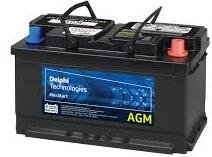

Leave a Reply